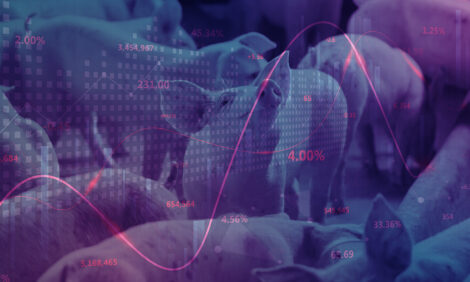



USDA Quarterly Pigs and Hogs Report: March 2004
This quarter's quarterly Hogs and Pigs report from the USDA's National Agricultural Statistics Service. The article provides the report text and graphs, and helps explain what it all means. Link also to the full PDF report.Introduction
This document aims to pull together, in one place of reference, all the various information generated by the USDA Quarterly report. This document includes: USDA Quarterly report: March 2004What it all means
Graph data from the report Hog Inventories by State (external link)
For a PRINTABLE VERSION of the full 24 page report in PDF format, including all the tabular data which is not shown in this article, Click Here
US Quarterly Pigs and Hogs Inventory: March 2004
U.S. inventory of all hogs and pigs on March 1, 2004, was 59.3 million head. This was 2 percent above March 1, 2003, but 2 percent below December 1, 2003.Breeding inventory, at 5.92 million head, was down 2 percent from March 1, 2003, and down 1 percent from last quarter.
Market hog inventory, at 53.4 million head, was 2 percent above last year, but 2 percent below last quarter.
The December 2003 - February 2004 U.S. pig crop, at 24.9 million head, was 2 percent more than 2003, and up slightly from 2002.
Sows farrowing during this period totaled 2.81 million head, 2 percent above last year. The sows farrowed during this quarter represented 47 percent of the breeding herd.
The average pigs saved per litter was 8.85 for the December 2003 - February 2004 period, compared to 8.81 last year. Pigs saved per litter by size of operation ranged from 7.60 for operations with 1-99 hogs to 9.00 for operations with more than 5,000 hogs and pigs.
US Quarterly Pigs and Hogs Inventory: March 1

Farrowing intentions: U.S. hog producers intend to have 2.85 million sows farrow during the March-May 2004 quarter, 1 percent below the actual farrowings during the same period in 2003, and 3 percent below 2002. Intended farrowings for June-August 2004, at 2.85 million sows, are 2 percent below the same period in 2003 and 1 percent below 2002.
The total number of hogs under contract, owned by operations with over 5,000 head, but raised by contractees, accounted for 38 percent of the total U.S. hog inventory, up from 35 percent last year.
Revisions
All inventory and pig crop estimates for March 2003 through December 2003 were reviewed using final pig crop, official slaughter, death loss, and updated import and export data. Based on the findings of this review, adjustments of less than one-half of one percent were made to the March 2003 and June 2003 total inventories. An adjustment of one percent was made to the September 2003 and December 2003 total inventories. An adjustment of less than one-half of one percent was made to the December 2002-February 2003 pig crop, March-May 2003 pig crop, and September-November 2003 pig crop. The June-August 2003 pig crop was adjusted three percent.
NASS has completed the 5-year historical review for March 1998 through December 2002. To ensure the continuity and availability of estimates to data users, December 1, 2003, breeding inventory, market inventory, and farrowings have been published on pages 13, 14, and 19 with any revisions. Final estimates were released on Monday, March 22, 2004, in the NASS Statistical Bulletin Number 986, Hogs and Pigs - Final Estimates 1998-2002.
What it all means?
What the commentators and industry thinkers read into this data:Ron Plain and Glen Grimes
Read what Ron Plain and Glen Grimes make of the March 1 Hogs and Pigs Report
Chris Hurt
Read what Chris Hurt, Extension Economist at the Purdue University has to say about the March 1 Hogs and Pigs Report
Mike Brumm
Dr Mike Brumm, Extension Swine Specialist, University of Nebraska comments on the latest USDA Hogs and Pigs report.
Graph Data from the Report
US Quarterly Litter Rate: Dec 03 - Feb 04

US Pigs Per Litter
By Size of Operation: Dec 03 - Feb 04

US Quarterly Sows Farrowed
Dec 03 - Feb 04

US Quarterly Pig Crop: Dec 03 - Feb 04

March 1 Hog Inventory and Market Hogs (US)

June 1 Hog Inventory and Market Hogs (US)

September 1 Hog Inventory and Market Hogs (US)

Reliability of March 1 Hogs and Pigs Estimates
Survey Procedures: A random sample of roughly 11,600 U.S. producers was surveyed to provide data for these estimates. Survey procedures ensured that all hog and pig producers, regardless of size, had a chance to be included in the survey. Large producers were sampled more heavily than small operations. Data were collected from about 9,500 operations, 82 percent of the total sample, during the first-half of March by mail, telephone, and face-to-face personal interviews. Regardless of when operations responded, they were asked to report inventories as of March 1.
Estimation Procedures: These hogs and pigs estimates were prepared by the Agricultural Statistics Board after reviewing recommendations and analysis submitted by each State office. National and State survey data were reviewed for reasonableness with each other and with estimates from past years using a balance sheet. The balance sheet begins with the previous inventory estimate, adds the estimates of births and imports, and subtracts the estimates of slaughter, exports, and deaths. This indicated ending inventory level is compared to the Agricultural Statistics Board estimate for reasonableness.
Revision Policy: Revisions to previous estimates are made to improve quarter to quarter relationships. Estimates for the previous four quarters are subject to revision when current estimates are made. In December, estimates for all quarters of the current and previous year are reviewed. The reviews are primarily based on hog check-off receipts and slaughter. Estimates will also be reviewed after data from the Department of Agriculture five-year Census of Agriculture are available. No revisions will be made after that date.
Reliability: Since all operations raising hogs are not included in the sample, survey estimates are subject to sampling variability. Survey results are also subject to non-sampling errors such as omissions, duplication, and mistakes in reporting, recording, and processing the data. The affects of these errors cannot be measured directly. They are minimized through rigid quality controls in the data collection process and through a careful review of all reported data for consistency and reasonableness.
To assist users in evaluating the reliability of the estimates in this report, the "Root Mean Square Error" is shown for selected items in the following table. The "Root Mean Square Error" is a statistical measure based on past performance and is computed using the difference between first and final estimates. The "Root Mean Square Error" for hog inventory estimates over the past 20 quarters is 1.1 percent. This means that chances are 2 out of 3 that the final estimate will not be above or below the current estimate of 59.3 million head by more than 1.1 percent. Chances are 9 out of 10 that the difference will not exceed 1.9 percent.
Source: Quarterly Hogs and Pigs Report, March 2004 - USDA National Agricultural Statistics Service








